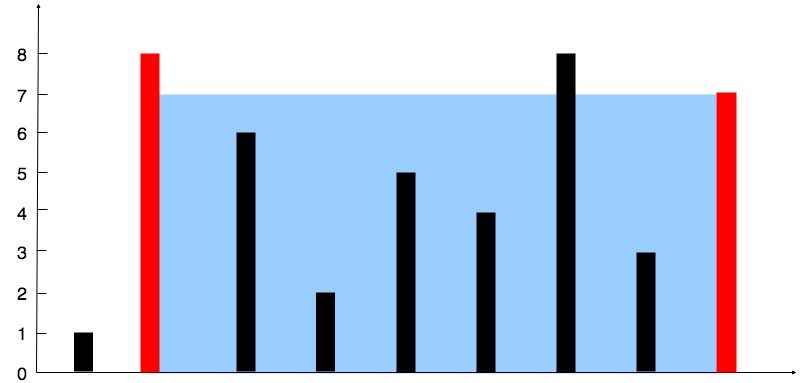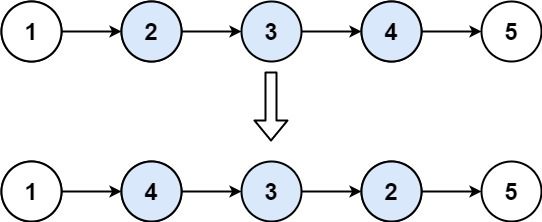Java每日一练(20230320)

目录
1. 两数之和 🌟🌟
2. 盛最多水的容器 🌟🌟
1. 两数之和
给定一个整数数组 nums 和一个整数目标值 target,请你在该数组中找出 和为目标值 的那 两个 整数,并返回它们的数组下标。
你可以假设每种输入只会对应一个答案。但是,数组中同一个元素在答案里不能重复出现。
你可以按任意顺序返回答案。
示例 1:
输入:nums = [2,7,11,15], target = 9 输出:[0,1] 解释:因为 nums[0] + nums[1] == 9 ,返回 [0, 1] 。
示例 2:
输入:nums = [3,2,4], target = 6 输出:[1,2]
示例 3:
输入:nums = [3,3], target = 6 输出:[0,1]
提示:
2 <= nums.length <= 10^3-10^9 <= nums[i] <= 10^9-10^9 <= target <= 10^9- 只会存在一个有效答案
import java.util.*;
public class twoSum {
public static class Solution {
public static int[] twoSum(int[] nums, int target) {
Map<Integer, Integer> cache = new HashMap<>();
for (int i = 0; i < nums.length; i++) {
int distance = target - nums[i];
if (cache.containsKey(distance)) {
return new int[] { cache.get(distance), i };
} else {
cache.put(nums[i], i);
}
}
return new int[] {};
}
}
public static void main(String[] args) {
Solution s = new Solution();
int nums[] = {2,7,11,5};
int res[] = s.twoSum(nums, 9);
for (int i = 0; i < res.length; i++) {
System.out.print(res[i] + " ");
}
System.out.println();
int nums2[] = {3,2,4};
int res2[] = s.twoSum(nums2, 6);
for (int i = 0; i < res2.length; i++) {
System.out.print(res2[i] + " ");
}
System.out.println();
int nums3[] = {3,3};
int res3[] = s.twoSum(nums3, 6);
for (int i = 0; i < res3.length; i++) {
System.out.print(res3[i] + " ");
}
System.out.println();
}
}输出:
0 1
1 2
0 1
2. 盛最多水的容器
给你 n 个非负整数 a1,a2,...,an,每个数代表坐标中的一个点 (i, ai) 。在坐标内画 n 条垂直线,垂直线 i 的两个端点分别为 (i, ai) 和 (i, 0) 。找出其中的两条线,使得它们与 x 轴共同构成的容器可以容纳最多的水。
说明:你不能倾斜容器。
示例 1:

输入:[1,8,6,2,5,4,8,3,7] 输出:49 解释:图中垂直线代表输入数组 [1,8,6,2,5,4,8,3,7]。在此情况下,容器能够容纳水(表示为蓝色部分)的最大值为 49。
示例 2:
输入:height = [1,1] 输出:1
示例 3:
输入:height = [4,3,2,1,4] 输出:16
示例 4:
输入:height = [1,2,1] 输出:2
提示:
n = height.length2 <= n <= 3 * 10^40 <= height[i] <= 3 * 10^4
代码:
import java.util.*;
public class maxArea {
public static class Solution {
public int maxArea(int[] height) {
int N = height.length;
int i = 0;
int j = N - 1;
int max = 0;
while (i < j) {
int c = (j - i) * Math.min(height[i], height[j]);
if (c > max) {
max = c;
}
if (height[i] > height[j]) {
j--;
} else {
i++;
}
}
return max;
}
}
public static void main(String[] args) {
Solution s = new Solution();
int height[] = {1,8,6,2,5,4,8,3,7};
System.out.println(s.maxArea(height));
int height2[] = {1,1};
System.out.println(s.maxArea(height2));
int height3[] = {4,3,2,1,4};
System.out.println(s.maxArea(height3));
int height4[] = {1,2,1};
System.out.println(s.maxArea(height4));
}
}输出:
49
1
16
2
3. 反转链表 II
给你单链表的头指针 head 和两个整数 left 和 right ,其中 left <= right 。请你反转从位置 left 到位置 right 的链表节点,返回 反转后的链表 。
示例 1:

输入:head = [1,2,3,4,5], left = 2, right = 4 输出:[1,4,3,2,5]
示例 2:
输入:head = [5], left = 1, right = 1 输出:[5]
提示:
- 链表中节点数目为
n 1 <= n <= 500-500 <= Node.val <= 5001 <= left <= right <= n
代码:
import java.util.Arrays;
public class reverseBetween {
public static class ListNode {
int val;
ListNode next;
ListNode(int x) { val = x; }
}
public static ListNode createLinkedList(int[] nums) {
if (nums == null || nums.length == 0) {
return null;
}
ListNode head = new ListNode(nums[0]);
ListNode cur = head;
for (int i = 1; i < nums.length; i++) {
cur.next = new ListNode(nums[i]);
cur = cur.next;
}
return head;
}
public static void printLinkedList(ListNode head) {
ListNode cur = head;
while (cur != null) {
System.out.print(cur.val + "->");
cur = cur.next;
}
System.out.println("null");
}
public static class Solution {
public ListNode reverseBetween(ListNode head, int m, int n) {
ListNode dummy = new ListNode(0);
dummy.next = head;
ListNode pre = dummy;
for (int i = 1; i < m; i++) {
pre = pre.next;
}
head = pre.next;
for (int i = m; i < n; i++) {
ListNode nex = head.next;
head.next = nex.next;
nex.next = pre.next;
pre.next = nex;
}
return dummy.next;
}
}
public static void main(String[] args) {
Solution s = new Solution();
int[] nums = {1,2,3,4,5};
ListNode head = createLinkedList(nums);
printLinkedList(head);
head = s.reverseBetween(head, 2, 4);
printLinkedList(head);
int[] nums2 = {5};
head = createLinkedList(nums2);
printLinkedList(head);
head = s.reverseBetween(head, 1, 1);
printLinkedList(head);
}
}输出:
1->2->3->4->5->null
1->4->3->2->5->null
5->null
5->null
递归法:
class Solution {
public ListNode reverseBetween(ListNode head, int left, int right) {
if (left == 1) {
return reverseN(head, right);
}
head.next = reverseBetween(head.next, left - 1, right - 1);
return head;
}
ListNode successor = null; // 后驱节点
// 反转以 head 为起点的 n 个节点,返回新的头结点
ListNode reverseN(ListNode head, int n) {
if (n == 1) {
successor = head.next;
return head;
}
ListNode last = reverseN(head.next, n - 1);
head.next.next = head;
head.next = successor;
return last;
}
}
完整代码如下:
public class reverseBetween {
public static class ListNode {
int val;
ListNode next;
ListNode(int x) { val = x; }
}
public static ListNode createLinkedList(int[] nums) {
if (nums == null || nums.length == 0) {
return null;
}
ListNode head = new ListNode(nums[0]);
ListNode cur = head;
for (int i = 1; i < nums.length; i++) {
cur.next = new ListNode(nums[i]);
cur = cur.next;
}
return head;
}
public static void printLinkedList(ListNode head) {
ListNode cur = head;
while (cur != null) {
System.out.print(cur.val + "->");
cur = cur.next;
}
System.out.println("null");
}
public static class Solution {
public ListNode reverseBetween(ListNode head, int left, int right) {
if (left == 1) {
return reverseN(head, right);
}
head.next = reverseBetween(head.next, left - 1, right - 1);
return head;
}
ListNode successor = null; // 后驱节点
// 反转以 head 为起点的 n 个节点,返回新的头结点
ListNode reverseN(ListNode head, int n) {
if (n == 1) {
successor = head.next;
return head;
}
ListNode last = reverseN(head.next, n - 1);
head.next.next = head;
head.next = successor;
return last;
}
}
public static void main(String[] args) {
Solution s = new Solution();
int[] nums = {1,2,3,4,5};
ListNode head = createLinkedList(nums);
printLinkedList(head);
head = s.reverseBetween(head, 2, 4);
printLinkedList(head);
int[] nums2 = {5};
head = createLinkedList(nums2);
printLinkedList(head);
head = s.reverseBetween(head, 1, 1);
printLinkedList(head);
}
}🌟 每日一练刷题专栏 🌟
✨ 持续,努力奋斗做强刷题搬运工!
👍 点赞,你的认可是我坚持的动力!
🌟 收藏,你的青睐是我努力的方向!
✎ 评论,你的意见是我进步的财富!
 | Golang每日一练 专栏 |
 | Python每日一练 专栏 |
 | C/C++每日一练 专栏 |
 | Java每日一练 专栏 |
相关文章
- java字符串的拆分_Java中的字符串分割 .
- java 怎样卸载一个类_Java 动态卸载类[通俗易懂]
- java 随机数算法_Java随机数算法原理与实现方法实例详解
- 用java实现笛卡尔积_Java实现笛卡尔积
- Java分割字符串
- Java中ArrayList集合的基本使用
- 【JAVA】Java 日志打印规范
- JAVA判断当前日期是否是工作日,还是节假日
- ORA-29501: invalid or missing Java source, class, or resource name ORACLE 报错 故障修复 远程处理
- java设计模式之单例模式详解架构师
- Java多线程编程——进阶篇一详解编程语言
- MySQL与Java的强强联合:开启智能数据库时代(mysql和java)
- Linux环境下编译Java程序的指南(linux编译java)
- JAVA多态中的隐藏和覆盖详解编程语言
- Java与Oracle联手构建数据库新世界(java和oracle)
- 时间 Java处理Redis数据过期时间(redisjava过期)
- 时间设置Java操作Redis:设置过期时间的技巧(redisjava过期)
- 基于Linux操作系统上实现 Java 编程(linux r java)
- 并发Redis锁保障Java并发性(redis锁实现java)
- Redis中使用Java快速实现自增(redis自增 java)
- Java实现按中文首字母排序的具体实例

